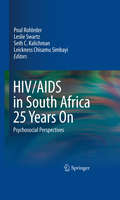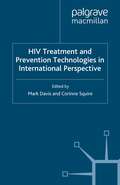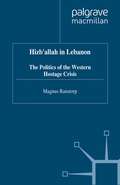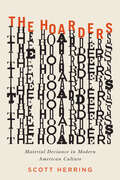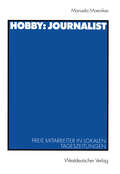- Table View
- List View
HIV/AIDS in China and India: Governing Health Security
by C. LoThis book compares the policy approaches taken by China and India in dealing with HIV/AIDS, illuminating the challenges they face as they grapple with this intractable disease and identifying best practices for dealing with HIV/AIDS in the developing world and beyond.
HIV/AIDS in Rural Communities: Research, Education, and Advocacy
by Fayth M. Parks Gregory S. Felzien Sally JueThis wide-ranging volume reviews the experience and treatment of HIV/AIDS in rural America at the clinical, care system, community, and individual levels. Rural HIV-related phenomena are explored within healthcare contexts (physician shortages, treatment disparities) and the social environment (stigma, the opioid epidemic), and contrasted with urban frames of reference. Contributors present latest findings on HIV medications, best practices, and innovative opportunities for improving care and care settings, plus invaluable first-person perspective on the intersectionality of patient subpopulations. These chapters offer both seasoned and training practitioners a thorough grounding in the unique challenges of providing appropriate and effective services in the region. Featured topics include: Case study: Georgia’s rural vs. non-rural populations HIV medications: how they work and why they fail Pediatric/adolescent HIV: legal and ethical issues Our experience: HIV-positive African-American women in the Deep South Learning to age successfully with HIV Bringing important detail to an often-marginalized population, HIV/AIDS in Rural Communities will interest and inspire healthcare practitioners including physicians, nurse practitioners, physician assistants, pharmacists, case managers, psychologists, social workers, counselors, and family therapists, as well as educators, students, persons living with HIV, advocates, community leaders, and policymakers.
HIV/AIDS in Russia and Eurasia: Volume I
by J. TwiggRussia and a few other Eurasian countries have been home to the fastest growing epidemics of HIV in the world over the last several years. This volume offers country-specific accounts, authored by the leading players in the analysis of the situation and the fight against the virus.
HIV/AIDS in Russia and Eurasia, Volume II
by J. TwiggRussia and a few other Eurasian countries have been home to the fastest growing epidemics of HIV in the world over the last several years. This volume offers country-specific accounts, authored by the leading players in the analysis of the situation and the fight against the virus.
HIV/AIDS in South Africa 25 Years On: Psychosocial Perspectives
by Poul Rohleder Leslie Swartz Seth C. Kalichman Leickness Chisamu SimbayiMuch has happened since the first appearance of AIDS in 1981: it has been identified, studied, and occasionally denied. The virus has shifted host populations and spread globally. Medicine, the social sciences, and world governments have joined forces to combat and prevent the disease. And South Africa has emerged as ground zero for the pandemic.The editors of HIV/AIDS in South Africa 25 Years On present the South African crisis as a template for addressing the myriad issues surrounding the epidemic worldwide, as the book brings together a widely scattered body of literature, analyzes psychosocial and sexual aspects contributing to HIV transmission and prevention, and delves into complex intersections of race, gender, class, and politics. Including largely overlooked populations and issues (e.g., prisoners, persons with disabilities, stigma), as well as challenges shaping future research and policy, the contributors approach their topics with rare depth, meticulous research, carefully drawn conclusions, and profound compassion. Among the topics covered: The relationship between HIV and poverty, starting from the question, "Which is the determinant and which is the consequence?"Epidemiology of HIV among women and men: concepts of femininity and masculinity, and gender inequities as they affect HIV risk; gender-specific prevention and intervention strategies. The impact of AIDS on infants and young children: risk and protective factors; care of children by HIV-positive mothers; HIV-infected children.Current prevention and treatment projects, including local-level responses, community-based work, and VCT (voluntary counseling and testing) programs.New directions: promoting circumcision, vaccine trials, "positive prevention."South Africa’s history of AIDS denialism.The urgent lessons in this book apply both globally and locally, making HIV/AIDS in South Africa 25 Years On uniquely instructive and useful for professionals working in HIV/AIDS and global public health.
HIV and Young People: Risk and Resilience in the Urban Slum (SpringerBriefs in Public Health)
by Gary JonesRevisiting the thinking on vulnerability to HIV and risk of infection, this book provides better understanding by considering the risk of HIV infection alongside notions of personal and collective resilience, dignity and humiliation.The work shows that young people in the urban slum dignify their world and, in doing so, establish priorities and draw on a set of references oftentimes intelligible to them alone. Moreover, humiliation, as an interpersonal event, adds to a sense of vulnerability and lies closely behind choices directly affecting personal health and livelihood. Thus, dignity and humiliation are shown for the first time to have a critical role in health seeking and risky behavior related to HIV, and this is an area in great need of further research. The crucial focus of this work is further emphasized by the rapid growth of urban slums, and high rates of HIV among both slum dwellers and young people, who continue to bear the brunt of the AIDS epidemic, thirty years on. This comprehensive literature review provides a compelling argument that the time is right to further explore the nexus of risk and resilience from a people-centered perspective. Fresh insight is critical to reach the goal of ending AIDS by 2030.
HIV in World Cultures: Three Decades of Representations
by Gustavo SuberoThis book analyses the way that HIV/AIDS is often narrativised and represented in contemporary world cultures, as well as the different strategies of remembrance deployed by different (sub)cultural groups affected by the illness. Through a close study of a variety of cultural texts; including cinema, literature, theatre, art and photography amongst others, it demonstrates the trajectory that such narratives and representations have undergone since the advent of the ’discovery’ of the disease in the 1980s. Acknowledging the central - yet often overlooked - role that cultural products have played in the construction of public opinion towards the condition itself and those who suffer it, this ground-breaking volume focuses on a variety of narratives, as well as strategies of coping with HIV/AIDS that have emerged across the globe. Bringing together research on the UK, North and South America, Africa and China, it provides rich textual analyses of the ways in which the HIV positive body has been portrayed in contemporary culture, with attention to the differences between specific national contexts, whilst keeping in view a space of commonality amongst the different experiences reflected in such texts. As such, it will be of interest to social scientists and scholars of cultural and media studies, concerned with cultural production and representations of the body and sickness.
HIV in World Cultures: Three Decades of Representations
by Gustavo SuberoThis book analyses the way that HIV/AIDS is often narrativised and represented in contemporary world cultures, as well as the different strategies of remembrance deployed by different (sub)cultural groups affected by the illness. Through a close study of a variety of cultural texts; including cinema, literature, theatre, art and photography amongst others, it demonstrates the trajectory that such narratives and representations have undergone since the advent of the ’discovery’ of the disease in the 1980s. Acknowledging the central - yet often overlooked - role that cultural products have played in the construction of public opinion towards the condition itself and those who suffer it, this ground-breaking volume focuses on a variety of narratives, as well as strategies of coping with HIV/AIDS that have emerged across the globe. Bringing together research on the UK, North and South America, Africa and China, it provides rich textual analyses of the ways in which the HIV positive body has been portrayed in contemporary culture, with attention to the differences between specific national contexts, whilst keeping in view a space of commonality amongst the different experiences reflected in such texts. As such, it will be of interest to social scientists and scholars of cultural and media studies, concerned with cultural production and representations of the body and sickness.
HIV Treatment and Prevention Technologies in International Perspective
by M. Davis C. SquireThis edited collection investigates the biomedical and social technologies used to control the HIV pandemic through case studies and critical commentaries from Africa, Europe, North America and Australia. With reference to global and local complexities, the volume engages with HIV treatment access, community-based health promotion, sexual health, HIV prevention and the relations between treatment and prevention. The volume includes chapters from leading authors in their fields and takes a trans-disciplinary approach by making reference to theoretical and empirical research from sociology, psychology, cultural studies and science and technology studies, thus helping to establish new ways of understanding current and future configurations of HIV technologies.
Hivemind: The New Science of Tribalism in Our Divided World
by Sarah Rose CavanaghCavanagh brings you along on her journey through an exquisite collection of scholarly knowledge and empirical insight to ground both your mind and your gut. From zombies to bees, moral panics to conspiracy theories, Hivemind mixes the dark with the light to help readers find a path through a very destabilizing present' - Danah Boyd, author of It's Complicated: The Social Lives of Networked Teens'This fascinating book guides us through the nuanced landscape of why we think and behave the way we do-online and off-and offers a much-needed vision for how we can find our way back from the edge'- Scott Barry Kaufman, Psychologist at Columbia University and co-author of Wired to Create'Hivemind provides a fascinating tour of research that reveals our social nature, for good and for bad. Cavanagh is a natural teacher whose enthusiasm for psychology shines through on every page. Whether you're looking to have healthier technology habits, develop better relationships with others, or address societal challenges, this book will give you food for thought and wisdom to take action' - Kelly McGonigal, author of The Joy of Movement and The Willpower Instinct+++Hivemind: A collective consciousness in which we share consensus thoughts, emotions, and opinions; a phenomenon whereby a group of people function as if with a single mind.Our views of the world are shaped by the stories told by our self-selected communities. Whether seeking out groups that share our tastes, our faith, our heritage, or other interests, since the dawn of time we have taken comfort in defining ourselves through our social groups. But what happens when we only socialize with our chosen group, to the point that we lose the ability to connect to people who don't share our passions? What happens when our tribes merely confirm our world view, rather than expand it? Leading a narrative journey from the site of the Charlottesville riots to the boardrooms of Facebook, considering such diverse topics as zombies, neuroscience, and honeybees, psychologist and emotion regulation specialist Sarah Rose Cavanagh leaves no stone unturned in her quest to understand how social technology is reshaping the way we socialize. It's not possible to turn back the clocks, and Cavanagh argues that there's no need to; instead, she presents a fully examined and thoughtful call to cut through our online tribalism, dial back our moral panic about screens and mental health, and shore up our sense of community. With compelling storytelling and shocking research, Hivemind is a must-read for anyone hoping to make sense of the dissonance around us.
Hizb'Allah in Lebanon: The Politics of the Western Hostage Crisis
by M. RanstorpThe abduction of Western citizens by Hizb'Allah was motivated either by internal organisational requirements or in alignment with Syrian and Iranian interests, and mechanisms for the resolution of the hostage-crisis were subject to continuous interaction between Hizb'Allah, Iran, and Syria influenced by internal Lebanese, regional, and international events. The Western responses to the hostage-crisis showed limited effectiveness as the crisis management techniques were poorly adjusted in timing and direction to the actual crisis environment. With the exception of the French response, the overall employment of Western crisis management techniques showed disregard for the opportunities and constraints in the fluctuating relationship between Syria and Iran as well as the political environment within Lebanon which the Hizb'allah operates and exists. This was clear by their failure to rely on either Iran or Syria as the only channel in negotiations over hostages without regard to their individual ability to exert its influence over the Lebanese movement in accordance with shifts in their ties to Hizb'allah's command leadership between 1987-1991 and to the status of the Iranian-Syrian relationship over time, as displayed by the friction between 1986-92. This study provides a new approach in the study of terrorism by merging a case-study of the dynamics of the Lebanese hostage-crisis with an evaluation of Western responses through crisis management techniques in order to more closely resolve the dilemma of the fulfilment of these states' duty to protect their citizens taken hostage abroad, without major sacrifices in the conduct of foreign policy.
Hizmet in Transitions: European Developments of a Turkish Muslim-Inspired Movement
by Paul WellerIn this open-access monograph, Paul Weller explores how the movement known as Hizmet (meaning “service”) is undergoing a period of transitions in Europe. Inspired by the teaching and practice of the Turkish Islamic scholar, Fethullah Gülen, Hizmet has been active in Europe (and other continents) for several decades. It has always been subject to some degree of contestation, which has intensified following the July 2016 coup attempt in Turkey, for which the current Turkish government holds Fethullah Gülen and Hizmet as responsible – a claim they strongly deny. In Turkey, thousands of people associated with Hizmet have been imprisoned. In Europe, pressures have been brought to bear on the movement and its activities. In charting a way forward, Hizmet finds itself in a significant transitional period, the nature and possible future trajectories of which are explored in this volume. The book is informed by a comprehensive literature review and a recent research project which includes primary research interviews with key Hizmet figures in Europe and beyond. It contends that to properly understand Hizmet in Europe, one has to situate it in its interactive engagement both with its diverse European national contexts and with Fethullah Gülen’s teaching and practice.
The Hoarders: Material Deviance in Modern American Culture
by Scott HerringThe verb “declutter” has not yet made it into the Oxford English Dictionary, but its ever-increasing usage suggests that it’s only a matter of time. Articles containing tips and tricks on how to get organized cover magazine pages and pop up in TV programs and commercials, while clutter professionals and specialists referred to as “clutterologists” are just a phone call away. Everywhere the sentiment is the same: clutter is bad. In The Hoarders, Scott Herring provides an in-depth examination of how modern hoarders came into being, from their onset in the late 1930s to the present day. He finds that both the idea of organization and the role of the clutterologist are deeply ingrained in our culture, and that there is a fine line between clutter and deviance in America. Herring introduces us to Jill, whose countertops are piled high with decaying food and whose cabinets are overrun with purchases, while the fly strips hanging from her ceiling are arguably more fly than strip. When Jill spots a decomposing pumpkin about to be jettisoned, she stops, seeing in the rotting, squalid vegetable a special treasure. “I’ve never seen one quite like this before,” she says, and looks to see if any seeds remain. It is from moments like these that Herring builds his questions: What counts as an acceptable material life—and who decides? Is hoarding some sort of inherent deviation of the mind, or a recent historical phenomenon grounded in changing material cultures? Herring opts for the latter, explaining that hoarders attract attention not because they are mentally ill but because they challenge normal modes of material relations. Piled high with detailed and, at times, disturbing descriptions of uncleanliness, The Hoarders delivers a sweeping and fascinating history of hoarding that will cause us all to reconsider how we view these accumulators of clutter.
The Hoarders: Material Deviance in Modern American Culture
by Scott HerringThe verb “declutter” has not yet made it into the Oxford English Dictionary, but its ever-increasing usage suggests that it’s only a matter of time. Articles containing tips and tricks on how to get organized cover magazine pages and pop up in TV programs and commercials, while clutter professionals and specialists referred to as “clutterologists” are just a phone call away. Everywhere the sentiment is the same: clutter is bad. In The Hoarders, Scott Herring provides an in-depth examination of how modern hoarders came into being, from their onset in the late 1930s to the present day. He finds that both the idea of organization and the role of the clutterologist are deeply ingrained in our culture, and that there is a fine line between clutter and deviance in America. Herring introduces us to Jill, whose countertops are piled high with decaying food and whose cabinets are overrun with purchases, while the fly strips hanging from her ceiling are arguably more fly than strip. When Jill spots a decomposing pumpkin about to be jettisoned, she stops, seeing in the rotting, squalid vegetable a special treasure. “I’ve never seen one quite like this before,” she says, and looks to see if any seeds remain. It is from moments like these that Herring builds his questions: What counts as an acceptable material life—and who decides? Is hoarding some sort of inherent deviation of the mind, or a recent historical phenomenon grounded in changing material cultures? Herring opts for the latter, explaining that hoarders attract attention not because they are mentally ill but because they challenge normal modes of material relations. Piled high with detailed and, at times, disturbing descriptions of uncleanliness, The Hoarders delivers a sweeping and fascinating history of hoarding that will cause us all to reconsider how we view these accumulators of clutter.
The Hoarders: Material Deviance in Modern American Culture
by Scott HerringThe verb “declutter” has not yet made it into the Oxford English Dictionary, but its ever-increasing usage suggests that it’s only a matter of time. Articles containing tips and tricks on how to get organized cover magazine pages and pop up in TV programs and commercials, while clutter professionals and specialists referred to as “clutterologists” are just a phone call away. Everywhere the sentiment is the same: clutter is bad. In The Hoarders, Scott Herring provides an in-depth examination of how modern hoarders came into being, from their onset in the late 1930s to the present day. He finds that both the idea of organization and the role of the clutterologist are deeply ingrained in our culture, and that there is a fine line between clutter and deviance in America. Herring introduces us to Jill, whose countertops are piled high with decaying food and whose cabinets are overrun with purchases, while the fly strips hanging from her ceiling are arguably more fly than strip. When Jill spots a decomposing pumpkin about to be jettisoned, she stops, seeing in the rotting, squalid vegetable a special treasure. “I’ve never seen one quite like this before,” she says, and looks to see if any seeds remain. It is from moments like these that Herring builds his questions: What counts as an acceptable material life—and who decides? Is hoarding some sort of inherent deviation of the mind, or a recent historical phenomenon grounded in changing material cultures? Herring opts for the latter, explaining that hoarders attract attention not because they are mentally ill but because they challenge normal modes of material relations. Piled high with detailed and, at times, disturbing descriptions of uncleanliness, The Hoarders delivers a sweeping and fascinating history of hoarding that will cause us all to reconsider how we view these accumulators of clutter.
The Hoarders: Material Deviance in Modern American Culture
by Scott HerringThe verb “declutter” has not yet made it into the Oxford English Dictionary, but its ever-increasing usage suggests that it’s only a matter of time. Articles containing tips and tricks on how to get organized cover magazine pages and pop up in TV programs and commercials, while clutter professionals and specialists referred to as “clutterologists” are just a phone call away. Everywhere the sentiment is the same: clutter is bad. In The Hoarders, Scott Herring provides an in-depth examination of how modern hoarders came into being, from their onset in the late 1930s to the present day. He finds that both the idea of organization and the role of the clutterologist are deeply ingrained in our culture, and that there is a fine line between clutter and deviance in America. Herring introduces us to Jill, whose countertops are piled high with decaying food and whose cabinets are overrun with purchases, while the fly strips hanging from her ceiling are arguably more fly than strip. When Jill spots a decomposing pumpkin about to be jettisoned, she stops, seeing in the rotting, squalid vegetable a special treasure. “I’ve never seen one quite like this before,” she says, and looks to see if any seeds remain. It is from moments like these that Herring builds his questions: What counts as an acceptable material life—and who decides? Is hoarding some sort of inherent deviation of the mind, or a recent historical phenomenon grounded in changing material cultures? Herring opts for the latter, explaining that hoarders attract attention not because they are mentally ill but because they challenge normal modes of material relations. Piled high with detailed and, at times, disturbing descriptions of uncleanliness, The Hoarders delivers a sweeping and fascinating history of hoarding that will cause us all to reconsider how we view these accumulators of clutter.
The Hoarders: Material Deviance in Modern American Culture
by Scott HerringThe verb “declutter” has not yet made it into the Oxford English Dictionary, but its ever-increasing usage suggests that it’s only a matter of time. Articles containing tips and tricks on how to get organized cover magazine pages and pop up in TV programs and commercials, while clutter professionals and specialists referred to as “clutterologists” are just a phone call away. Everywhere the sentiment is the same: clutter is bad. In The Hoarders, Scott Herring provides an in-depth examination of how modern hoarders came into being, from their onset in the late 1930s to the present day. He finds that both the idea of organization and the role of the clutterologist are deeply ingrained in our culture, and that there is a fine line between clutter and deviance in America. Herring introduces us to Jill, whose countertops are piled high with decaying food and whose cabinets are overrun with purchases, while the fly strips hanging from her ceiling are arguably more fly than strip. When Jill spots a decomposing pumpkin about to be jettisoned, she stops, seeing in the rotting, squalid vegetable a special treasure. “I’ve never seen one quite like this before,” she says, and looks to see if any seeds remain. It is from moments like these that Herring builds his questions: What counts as an acceptable material life—and who decides? Is hoarding some sort of inherent deviation of the mind, or a recent historical phenomenon grounded in changing material cultures? Herring opts for the latter, explaining that hoarders attract attention not because they are mentally ill but because they challenge normal modes of material relations. Piled high with detailed and, at times, disturbing descriptions of uncleanliness, The Hoarders delivers a sweeping and fascinating history of hoarding that will cause us all to reconsider how we view these accumulators of clutter.
The Hoarders: Material Deviance in Modern American Culture
by Scott HerringThe verb “declutter” has not yet made it into the Oxford English Dictionary, but its ever-increasing usage suggests that it’s only a matter of time. Articles containing tips and tricks on how to get organized cover magazine pages and pop up in TV programs and commercials, while clutter professionals and specialists referred to as “clutterologists” are just a phone call away. Everywhere the sentiment is the same: clutter is bad. In The Hoarders, Scott Herring provides an in-depth examination of how modern hoarders came into being, from their onset in the late 1930s to the present day. He finds that both the idea of organization and the role of the clutterologist are deeply ingrained in our culture, and that there is a fine line between clutter and deviance in America. Herring introduces us to Jill, whose countertops are piled high with decaying food and whose cabinets are overrun with purchases, while the fly strips hanging from her ceiling are arguably more fly than strip. When Jill spots a decomposing pumpkin about to be jettisoned, she stops, seeing in the rotting, squalid vegetable a special treasure. “I’ve never seen one quite like this before,” she says, and looks to see if any seeds remain. It is from moments like these that Herring builds his questions: What counts as an acceptable material life—and who decides? Is hoarding some sort of inherent deviation of the mind, or a recent historical phenomenon grounded in changing material cultures? Herring opts for the latter, explaining that hoarders attract attention not because they are mentally ill but because they challenge normal modes of material relations. Piled high with detailed and, at times, disturbing descriptions of uncleanliness, The Hoarders delivers a sweeping and fascinating history of hoarding that will cause us all to reconsider how we view these accumulators of clutter.
Hoarders, Doomsday Preppers, and the Culture of Apocalypse
by Gwendolyn Audrey FosterThe culture of twenty-first century America revolves around narcissistic death, violence, and visions of doom. Foster explores this culture of the apocalypse, from hoarding and gluttony to visions of the post-apocalyptic world.
Hobby: Freie Mitarbeiter in lokalen Tageszeitungen (Journalistik: Forschungsimpulse für die Praxis)
by Monika MoenikesDie freien Mitarbeiter, besonders die nebenberuflichen, werden oft vernachlässigt und wie "Wasserträger" des Journalismus behandelt - zu Unrecht, denn freie Mitarbeiter füllen bis zu zwei Drittel der lokalen Zeitungsseiten. Darum läßt sich durch eine gezielte Betreuung der Freien das Niveau eines Blattes deutlich verbessern. Die Autorin hat am Beispiel einer Lokalzeitung untersucht, wie die "Freien" arbeiten und was sie über den Journalismus wissen. Sie analysiert die Artikel der "Hobbyjournalisten" unter Qualitätsgesichtspunkten. Auf der Basis ihrer Analyse hat die Autorin einen Qualifizierungs-Workshop für freie Mitarbeiter konzipiert, der sich bereits in der Praxis bewährt hat. Dieses Seminar wird ausführlich vorgestellt, so daß es Lokalredakteuren als Anregung dienen kann.
Hochachtsamkeit: Über unsere Grenze des Ressortdenkens (essentials)
by Jan-Philipp Küppers E. W. KüppersDieses Essential vermittelt einen grundlegenden Einblick in die Hochachtsamkeit als Ressortgrenzen überwindende Art zu denken und zu handeln. An wachsenden Krisenherden und Umbruchsituationen in Gesellschaft und Politik sind Organisationen, ihre Strukturen und Abläufe nicht gänzlich unbeteiligt. Die Autoren erläutern auf leicht verständliche Weise, welchen Wert Hochachtsamkeit für Problemlösungen bietet und welche Rolle dabei ein besseres Verständnis von Organisationsstrukturen und darin stattfindenden Arbeitsprozessen einnimmt.
Hochaltrigkeit: Herausforderung für persönliche Lebensführung und biopsychosoziale Arbeit (Integrative Modelle in Psychotherapie, Supervision und Beratung)
by Hilarion Petzold Erika Horn Lotti MüllerIn der Politik wird die sogenannte Vergreisung der Gesellschaft meist als Problem gesehen, z.B. für die Rentenkassen oder das Gesundheitssystem, doch sind mit dem hohen Alter auch positive Aspekte verbunden: Das Buch beleuchtet in interdisziplinärer Sicht Probleme, Herausforderung und Chancen der Hochaltrigkeit - sowohl aus gesellschaftlicher, vor allem aber aus individueller Perspektive. Mit einem modernen, biopsychosozialen Ansatz werden wichtige Themen wie das alternde Gehirn, die psychologische Leistungsfähigkeit, Entwicklungsprozesse, Willensdynamik, Bewegungsaktivität in ihrer Bedeutung für Begleitung, Pflege, Bildungsarbeit, Psychotherapie und die Förderung einer Lebenskunst im hohen Alter ausführlich behandelt. Menschen, die mit Hochbetagten zu tun haben oder arbeiten, finden in diesem Buch nicht nur einen guten Überblick über die aktuellen wissenschaftlichen Entwicklungen in diesem interdisziplinären Arbeitsfeld, sondern auch viele An- regungen für den Umgang mit hochaltrigen Mitbürgerinnen und Informationen für ihr eigenes Altern.
Hochqualifizierte Transmigrantinnen: Bildungswege und Migrationserfahrungen zwischen Befremdung und Beheimatung (Interkulturelle Studien)
by Nora WarrachAn der Gruppe türkeistämmiger hochqualifizierter Frauen, die ein transnationales Leben zwischen Deutschland und der Türkei führen, wird nachgezeichnet, wie sie vor ihrem Bildungshintergrund mit Befremdungserfahrungen umgehen und wie sie Beheimatungsstrategien entwerfen. Der Einblick in die Biographien der hochqualifizierten Transmigrantinnen zeigt, dass sich „Zugehörigkeitsgrenzen“ verschieben und „Werte-Patchworks“ entstehen. Gerade ihre Erfahrungen der Etikettierung als „Fremde“ nehmen sie als Chance denn als Schicksal wahr, die letztlich als Motor für ihr Streben nach Selbstverwirklichung fungieren. Damit brechen sie stereotypisierte Bilder über türkeistämmige Frauen auf.
Hochschule als Organisation (Organisationssoziologie)
by Uwe Wilkesmann Christian SchmidHochschulen sind im Wandel und befinden sich seit einigen Jahren auf dem Weg zu korporativen Akteuren. Ursprünglich war der Modus ihrer Entscheidungsstrukturen zwischen Interessensorganisationen und Arbeitsorganisationen angesiedelt. Mittlerweile verschiebt sich dieser Modus immer mehr in Richtung Arbeitsorganisation. Einige Universitäten werben sogar damit, eine unternehmerische Hochschule zu sein. Dieser Wandel beeinflusst sowohl ihre Organisationsidentität, ihre internen Steuerungsoptionen und -mechanismen, als auch die Produktionsebene von Forschung und Lehre sowie externe Netzwerke. Es gab und gibt in der jüngsten Zeit einige empirische Forschungsprojekte, die den Wandel der Universitäten in Richtung Organisation in den Blick genommen haben. Die Ergebnisse sollen in diesem Sammelband dokumentiert werden.
Hochschulen: Fragestellungen, Ergebnisse und Perspektiven der sozialwissenschaftlichen Hochschulforschung (Organization & Public Management)
by Otto Hüther Georg KrückenDas Buch gibt einen Überblick über zentrale Forschungsergebnisse der wissenschaftlichen Beschäftigung mit Hochschulsystemen und Hochschulorganisationen. Einen besonderen Fokus legen die Autoren hierbei auf die vielfältigen Reformen und Veränderungen der letzten Jahre, wie neuartige Governance- und Organisationsstrukturen, die Bologna-Reform sowie die zunehmende Inklusion breiterer Bevölkerungsschichten. Dieser umfassende Wandel wird unter verschiedenen Perspektiven ausführlich dargestellt und diskutiert.




